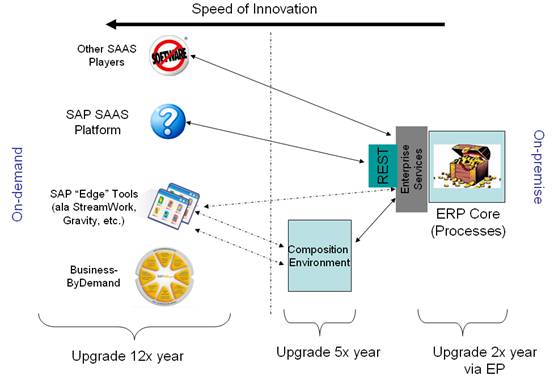
- SAP Community
- Products and Technology
- Additional Blogs by Members
- Quick thoughts on on-demand and on-premise environ...
- Subscribe to RSS Feed
- Mark as New
- Mark as Read
- Bookmark
- Subscribe
- Printer Friendly Page
- Report Inappropriate Content
Last week, SalesForce released the beta of its collaborative feature Chatter to selected customers and partners. As co-project lead for Apache ESME, I watched the release presentations to see how this technology was being used in a SAAS environment. Like many in IT, I've followed the development of on-demand software and not only have I developed on cloud-based platforms but I've also integrated such platforms into on-premise environments. During the presentations about Chatter however, I had an epiphany regarding the power of such platforms. I thought abut how much time / effort it would take to provide an innovation (such as ESME) to existing on-premise customers. I admit I was envious.
Salesforce provides a SAAS-based development environment (Force.com) and since Chatter is an integral part of this platform, developers using this environment had this functionality available for their customers with limited integration work. Compare this to developers who develop software for various on-premise customers. For such customers, the necessity of deploying such new core functionality across all layers takes a lot longer. This ease and speed of deployment means that such innovations are much more rapidly available to end-users of SAAS systems.
NOTE: On-demand systems also have a variety of problems associated with them. There are other blogs that discuss such issues.
Although SAP has a wide variety of on-demand innovations (BByD, StreamWork, Gravity, etc.) their main focus is still on on-premise - also because of the large existing customer base - many of which are still on older legacy systems. For such customers, a stable core is critical. Despite the associated demand for stability (users don't want to continually implement upgrade projects) , there has been criticism recently from analysts and other pundits that SAP has lost its mojo and isn't innovative. If you look at the various developments that occur at the edges (SAPLabs, etc.), you'll find, however, that innovation is there but hasn't moved to the ERP core as rapidly as some have desired.
In my opinion, SAP's treasure chest is the immense process-related knowledge / experience that is stored in these back-end systems and it is this foundation that differentiates SAP from the competitors. SalesForce might not have the "baggage" of existing on-premise customers but they also don't have the experience that is based on the long-term interaction with such customers. Many of the SAAS newcomers might have a technological advantage (ease of deployment, etc.) that comes from being a pure on-demand platform, however, the broad base of knowledge in a wide variety of industries isn't present - yet.
The $10,000 question is how do you combine this immense on-premise process knowledge to the on-demand platforms with their intrinsic innovative speed / potential. The easiest answer is to open up APIs on the on-premise systems for use in on-demand environments. The question is which APIs do you provide? In the case of SAP, would this be Enterprise Services? Something simpler - perhaps REST-based? Although there are certain restrictions to such access - many of which are related to fundamental Corporate IT issues (security, identity management, etc.), the technology to make such APIs available to on-demand environments isn't a problem. These APIs have existed for a while - what is missing is the SAAS offering from SAP to take advantage of these services.
The following diagram provides my interpretation of the current situation.

Note: The number of actual upgrades is probably different in each environment but I wanted to give a general feeling for the distinctions regarding such upgrades.
- Other SAAS Players. There are other SAAS players who access SAP data and present this data in their environments. The problem with such arrangements is that SAP is then seen as providing the stable ERP Core but the innovations originate some place else.
- The Composition Environment (CE) has a faster innovative cycle than the ERP Core but its typical location on-premise is restrictive. Installing CEs in the cloud solves some of infrastructure-related problems but doesn't take advantage of the on-demand potential.
- BusinessByDemand focuses on the SME market for companies with between 100-500 employees. There are currently no equivalent on-demand options (offering a wide scope of ERP-related functionality) for customers of other sizes.
- SAP Edge Tools. There are a variety of interesting on-demand tools that originate from SAP but they focus more on collaboration-related scenarios that are largely independent of the core ERP-based processes.
- SAP SAAS Platform. This SAAS tool is currently missing from the SAP portfolio. I'd like to see something similar to Force.com but with a tighter integration with the core ERP processes.
There is no single answer to this dilemma associated with demonstrating innovation and stability. The situation is complicated by the fact that different customer types place a different emphasis on which characteristic is more important. I also do not have the solution but asking the questions is sure fun.
- Empowering Retail Business with a Seamless Data Migration to SAP S/4HANA in Technology Blogs by Members
- 10+ ways to reshape your SAP landscape with SAP BTP - Blog 4 Interview in Technology Blogs by SAP
- 10+ ways to reshape your SAP landscape with SAP Business Technology Platform – Blog 4 in Technology Blogs by SAP
- The 1H 2024 Release of SAP SuccessFactors Learning – Release Highlights in Human Capital Management Blogs by Members
- RISE with SAP advanced asset and service management package in Supply Chain Management Blogs by SAP